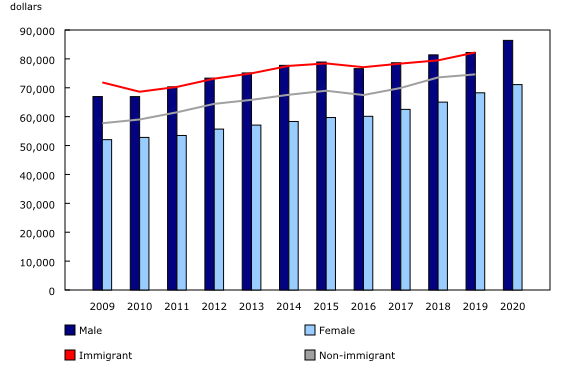Environmental and Clean Technology Products Economic Account: Human Resource Module, 2020
Released: 2022-04-28
In 2020, environmental and clean technology (ECT) activity generated 322,972 employee jobs in the Canadian economy, down 5% from the previous year, reflecting the economic difficulties caused by the COVID-19 pandemic. The ECT sector represented almost 2% of all jobs in Canada in 2020.
By adding the 22,086 self-employed jobs to the employee jobs, the Canadian ECT sector reached a total of 345,058 jobs in 2020. For the following analysis, the term "jobs" is used to refer to employee jobs.
Two broad categories of jobs are associated with the production and delivery of ECT products: those associated with environmental goods and services and those related to the provision of clean technology goods and services.
The environmental products subsector represented almost 4 out of 10 jobs (or 119,831 jobs) in the ECT sector. This subsector includes the production of clean electricity, biofuels and primary goods, as well as the delivery of waste management and remediation services.
The remaining jobs (63% of the sector, or 203,141 jobs in 2020) were found in the clean technology products subsector, which includes the production of manufactured goods (e.g., solar panels, efficient turbines, electric batteries), as well as the delivery of professional, scientific and technical services; construction services; and support services.
The environmental and clean technology workforce is predominantly male
In 2020, men held 64% of jobs in the ECT sector (205 309 jobs), while the 117,663 remaining jobs were held by women. This share was similar to that of 2019. The two ECT subsectors presented a different gender distribution: 71% of the environment products subsector jobs were held by males in 2020, while they represented 59% in the clean technology products subsector.
The decline in jobs observed in the ECT sector from 2019 to 2020 similarly affected the number of jobs held by men (-4%, from 214,756 to 205,309 jobs) and women (-5%, from 123,939 to 117,663 jobs).
As in 2019, the ECT sector workforce was mostly aged from 25 to 54 years (almost 7 workers out of 10 in 2020). Each age group (25 to 34, 35 to 44, and 45 to 54 years) represented just over one-fifth of the labour force in 2020.
Average annual wages and salaries in the environmental and clean technology sector are higher than the national average
In 2020, average annual wage and salaries in the ECT sector reached $80,834, compared with $77,144 a year earlier. This amount was $12,156 higher than the Canadian economy average annual salary of $68,678.
On average, women earned 82% ($71,099) of men's salaries ($86,413) in 2020, compared with 78% reported in 2009.
Note to readers
The aim of the Human Resource Module (HRM) is to provide timely and reliable statistics on the human resources associated with environmental and clean technology activities production in Canada.
The HRM complements and enhances the analytical capacity provided by the Environmental and Clean Technology Products Economic Account and allows for a broader insight into the sector's role in the economy by providing more detailed human resource information (e.g., gender, age, education, immigration status, Indigenous identity, wages and occupation types).
Data for this module (2009 to 2020) are available upon request. They replace the data released on March 26, 2021, which covered the period from 2009 to 2019. This article provides a sample of the data available through the HRM.
Estimates for 2019 and 2020 are preliminary and will be revised when updated data become available, including the supply and use tables for those reference years. Estimates for 2020 are available for a limited number of variables. The complete set of variables will be accessible at the next release in 2023, when all the 2021 Census data will be available.
The HRM provides annual estimates that cover employee jobs only. These estimates are based on national data from the Canadian Productivity Accounts, which are a key input to the HRM, as well as Labour Force Survey data. Data from the 2006 and 2016 Census of Population, as well as from the 2011 National Household Survey, are also incorporated.
Environmental and clean technologies are defined as any process, product or service that reduces environmental impacts through any of the following three strategies: environmental protection activities that prevent, reduce or eliminate pollution or any other degradation of the environment; resource management activities that result in the more efficient use of natural resources, thus safeguarding against their depletion; or the use of goods that have been adapted to be significantly less energy or resource intensive than the industry standard.
Products
The infographic "Portrait of environmental and clean technology jobs in Canada, 2019" is now available as part of the series Statistics Canada — Infographics (11-627-M). The special tabulations produced by the Human Resource Module are available upon request.
Contact information
For more information, or to enquire about the concepts, methods or data quality of this release, contact us (toll-free 1-800-263-1136; 514-283-8300; infostats@statcan.gc.ca) or Media Relations (statcan.mediahotline-ligneinfomedias.statcan@statcan.gc.ca).
- Date modified:

